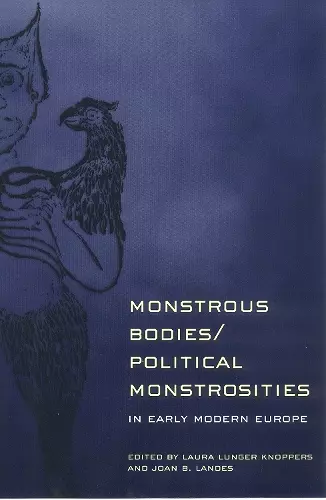Monstrous Bodies/Political Monstrosities in Early Modern Europe
Joan B Landes editor Laura Lunger Knoppers editor
Format:Paperback
Publisher:Cornell University Press
Published:15th Apr '04
Currently unavailable, and unfortunately no date known when it will be back
This paperback is available in another edition too:
- Hardback£108.00(9780801441769)

Multi-disciplinary in approach and cross-European in scope, this richly illustrated book features new links between the political and the monstrous in the early modern period. Emphasizing the importance of the visual in the culture of the monstrous, the book presents a range of striking engravings, woodcuts, broadsides, and anatomical works. Some of the most respected scholars of early modern Europe explore monstrous bodies in descriptions of aberrant births and grotesque anatomies, appropriations of classical or biblical beasts and harlots, satire, myth, and science fiction. Canonical writings on monstrosity by Aristotle, Ambroise Paré, Rabelais, Montaigne, and Mary Shelley are juxtaposed to less familiar treatments by Calvin, Luther, and Andrew Marvell, among others.
This volume challenges established narratives in which modern science and medicine, sustained by enlightened reason and secularization, progressively contain and even "normalize" all monsters. Instead, these essays stress the continual reinvention and polemical applications of the monstrous in the early modern period. Monsters emerge as a rich subject for not only the history of science, but also political and religious history, literary studies, visual studies, and the history of popular culture.
"Monstrous Bodies/Political Monstrosities in Early Modern Europe is more than just a further contribution to the growing historiographical monster industry, because it is a remarkable combination of fine scholarship and intellectual passion. Laura Lunger Knoppers and Joan B. Landes are to be commended for bringing together essays that admirably enrich our understanding of how monsters are represented in political, medical, and literary contexts. This ambitious book is a significant contribution to early modern social and cultural history."—Michael Hagner, ETH Zurich, Switzerland
"There can be few figures more marginal than those objects of fear, wonder, fascination, awe, or trepidation consigned to the category of the monstrous. The history of the monster is also the history of the darker side of the understanding of what it might mean to be fully human. As the editors of this fascinating collection of essays observe, 'monsters blur boundaries—transgressing, violating, polluting, and mixing what ought to be kept apart.' They act as a kind of litmus test of normality. Here, then, are eight timely, thoughtful, and meticulously argued essays, lavishly illustrated, each of which helps us to understand how the age that gave us Hobbes, Locke, Newton, Pascal, and Rousseau also gave us the headless monsters of the English Revolution, the monsters of the apocalypse, the strange births associated with the German Reformation, and the creatures to be found in Montaigne or Rabelais."—Jonathan Sawday, cultural historian, author of The Body Emblazoned, and Professor of English Studies, University of Strathclyde, Glasgow
"Monstrous Bodies/Political Monstrosities in Early Modern Europe focuses attention on an exquisitely (and variously) specified form of demonization, the discourse of monstrosity in an era before its containment by teratology and, eventually, genetic profiling and plastic surgery. An era of revolutions, theological as well as politic, the period had considerable and largely unpleasant use for the rhetoric, the imagery, and even the simulacra of monstrosity. It is a particular comfort, towards the end of the book, to be shown the period's own deconstructions and rejections of this heated discourse in the works of Rabelais and Montaigne. The authors collected here aim to perform a similar unwinding of the representational abuse to which the early modern monster lent itself so readily in the political arena."—Mary Baine Campbell, author of Wonder and Science: Imagining Worlds in Early Modern Europe
ISBN: 9780801489013
Dimensions: 229mm x 152mm x 22mm
Weight: 454g
320 pages